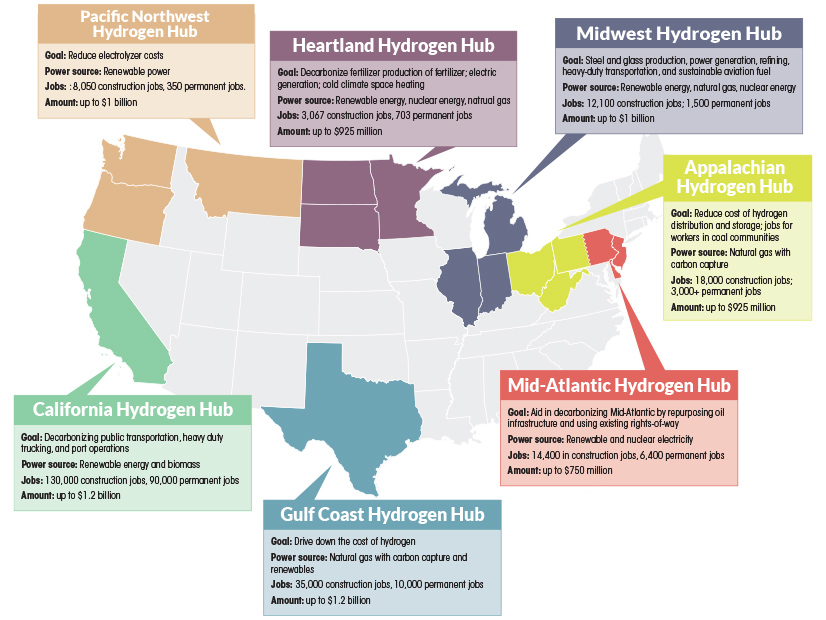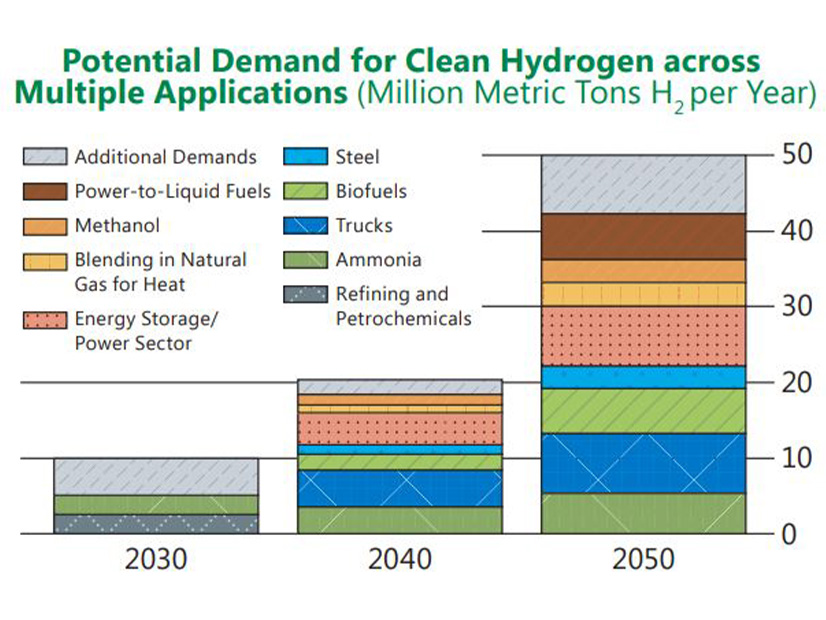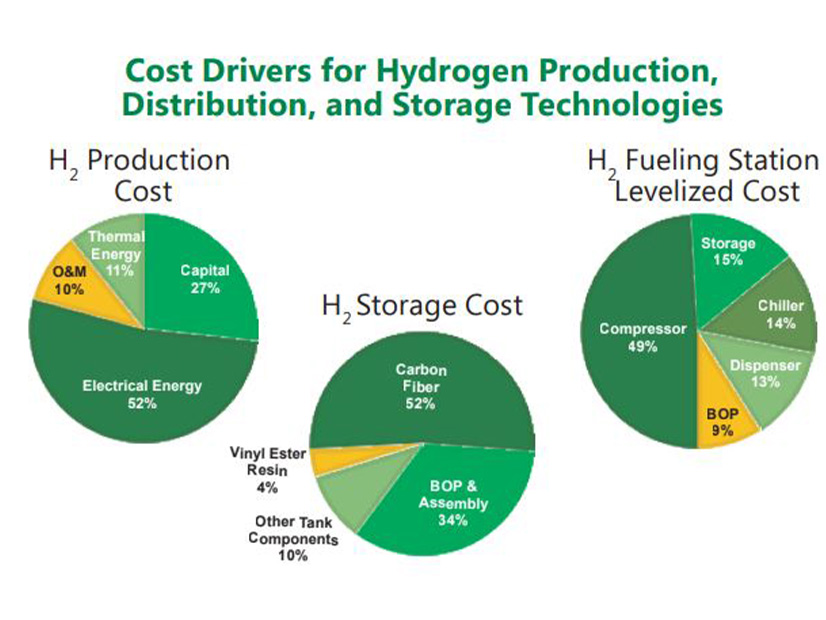If selected, the H2Hubs will benefit from up to $7 billion in federal funding that recipients will match with more than $40 billion in additional funding.
The U.S. Department of Energy this morning announced designation of seven potential clean hydrogen hubs, the foundation of the Biden administration’s plan for a technology it views as central to the clean energy economy.
If selected, the H2Hubs will benefit from up to $7 billion in federal funding that recipients will match with more than $40 billion in additional funding.
The seven regional hubs are a central piece of the Biden Administration’s attempts to accelerate hydrogen’s development as an alternative to fossil fuel. They are intended to pave the way for a national hydrogen production, distribution, storage and end-use network.
The seven hubs are expected to produce 3 million metric tons of hydrogen annually, enabling end users to reduce their carbon dioxide emissions by up to 25 million metric tons per year. The administration has set a 2030 production target of 10 million metric tons to serve industrial sectors that represent 30% of total U.S. carbon emissions.
DOE said its selection of the hubs does not commit it to provide funding. “Before funding is issued, DOE and the applicants will undergo a negotiation process, and DOE may cancel negotiations and rescind the selection for any reason during that time.”
The seven projects selected for negotiation are:
-
- Appalachian Hydrogen Hub (West Virginia, Ohio, Pennsylvania)
Goal: Reduce cost of hydrogen distribution and storage; jobs for workers in coal communities
Power source: Natural gas with carbon capture
Jobs: 18,000 construction jobs; 3,000+ permanent jobs
Amount: up to $925 million
-
- California Hydrogen Hub (California)
Goal: Decarbonizing public transportation, heavy duty trucking and port operations
Power source: Renewable energy and biomass
Jobs: 130,000 construction jobs, 90,000 permanent jobs
Amount: up to $1.2 billion
-
- Gulf Coast Hydrogen Hub (Texas)
Goal: Drive down the cost of hydrogen
Power source: Natural gas with carbon capture and renewables
Jobs: 35,000 construction jobs, 10,000 permanent jobs.
Amount: up to $1.2 billion
-
- Heartland Hydrogen Hub (Minnesota, North Dakota, South Dakota)
Goal: Decarbonize production of fertilizer; electric generation; cold climate space heating
Power source: Renewable energy, nuclear energy
Jobs: 3,067 construction jobs, 703 permanent jobs
Amount: up to $925 million
-
- Mid-Atlantic Hydrogen Hub (Pennsylvania, Delaware, New Jersey)
Goal: Aid in decarbonizing Mid-Atlantic by repurposing oil infrastructure and using existing rights-of-way
Power source: Renewable and nuclear electricity
Jobs: 14,400 in construction jobs, 6,400 permanent jobs
Amount: up to $750 million
-
- Midwest Hydrogen Hub (Illinois, Indiana, Michigan)
Goal: Steel and glass production, power generation, refining, heavy-duty transportation and sustainable aviation fuel
Power source: Renewable energy, natural gas, nuclear energy
Jobs: 12,100 construction jobs; 1,500 permanent jobs
Amount: up to $1 billion
-
- Pacific Northwest Hydrogen Hub (Washington, Oregon, Montana)
Goal: Reduce electrolyzer costs
Power source: Renewable power
Jobs: 8,050 construction jobs, 350 permanent jobs
Amount: up to $1 billion
DOE and the White House said the H2Hubs would create tens of thousands of jobs directly and tens of thousands more indirectly. Many would be temporary construction jobs but tens of thousands would be permanent.
The California, Mid-Atlantic and Pacific Northwest hubs have committed to negotiating project labor agreements with unions.
Hydrogen holds promise as a source of emissions-free energy for hard-to-decarbonize applications such as heavy-duty transportation and chemical, steel and cement manufacturing.
But most of the easily accessible hydrogen is locked in compounds with other elements and must be separated before it can become a fuel.
Further development is needed to produce clean hydrogen at high volume and low cost without generating excess emissions in the process. And exactly how to define “clean” remains a topic of debate. Friday’s announcement noted that hydrogen can be “produced with zero or near-zero carbon emissions.”
DOE and the White House said Friday that two thirds of the total H2Hub investment is expected to focus on “green” hydrogen, which uses emissions-free renewable or nuclear energy to power the electrolysis process. But several of the hubs plan to use natural gas with carbon capture, so-called “blue” hydrogen.
Clean energy advocates assert that to make truly green hydrogen, the renewable power must be from a new generation source, not an existing source. If existing renewable electricity is diverted to hydrogen production, its place on the grid might be backfilled with fossil fuel.
In June 2021, DOE launched the Hydrogen Shot, the first of its Energy Earthshots, with the goal of reducing the cost of clean hydrogen by 80% to $1 per kilogram.
The Biden administration has targeted hydrogen as an economic development engine as well as a source of emissions-free energy. DOE said today’s announcement is “one of the largest investments in clean manufacturing and jobs in history.”
“With this historic investment, the Biden-Harris Administration is laying the foundation for a new, American-led industry that will propel the global clean energy transition while creating high quality jobs and delivering healthier communities in every pocket of the nation,” said Energy Secretary Jennifer Granholm.




